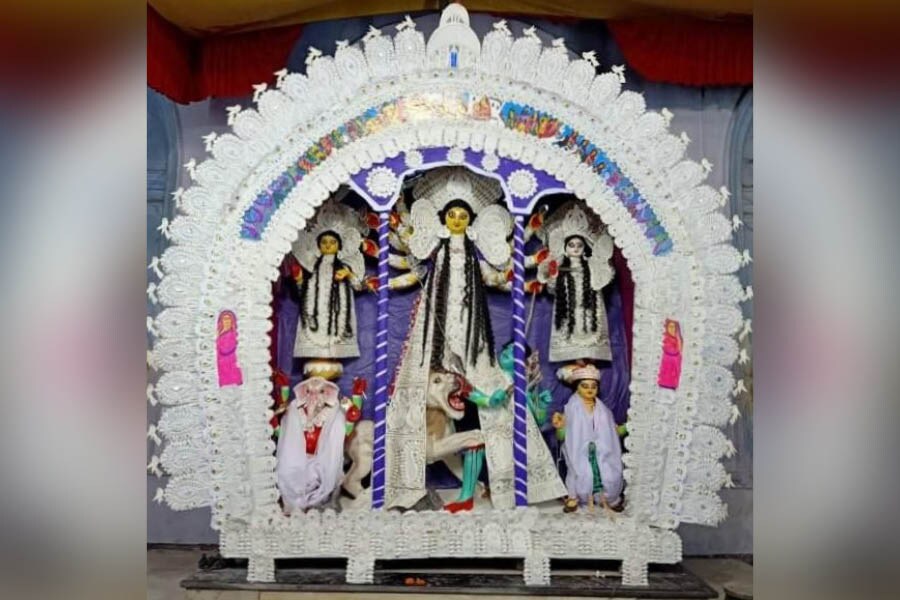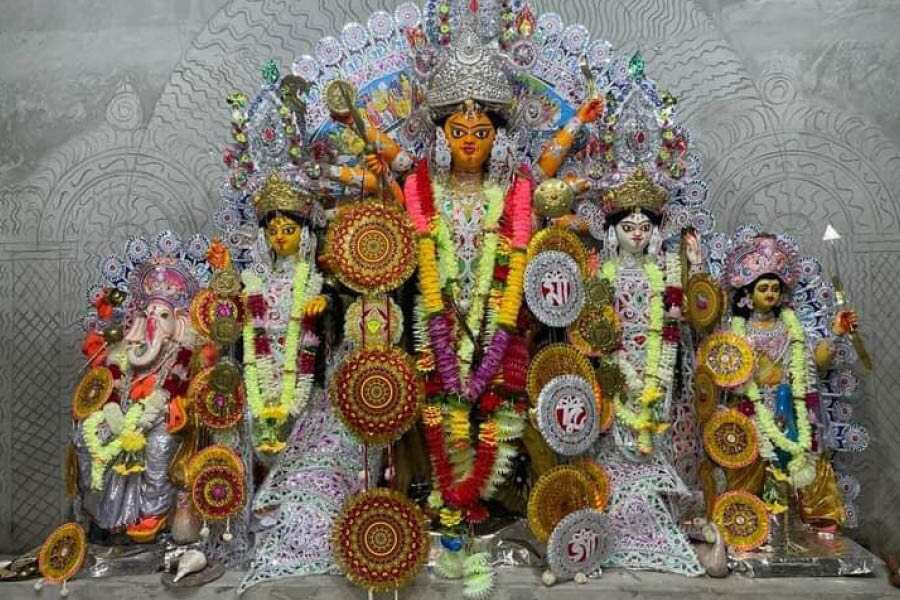Popularly known as Srirampur Rajbarir Durga Puja, this colossal mansion was home to ghosts in Anik Dutta’s Bhooter Bhabishyat welcomes Durga every year.
Trivia
If you’ve watched the 2012 cult film Bhooter Bhabishyat and visited its location, you might have felt a bit confused. Some parts of the exteriors seen in the movie seem to be missing. Only after walking around the entire mansion would you realise that the director deftly used cut shots of both the north and south blocks together to make the house look bigger on screen.
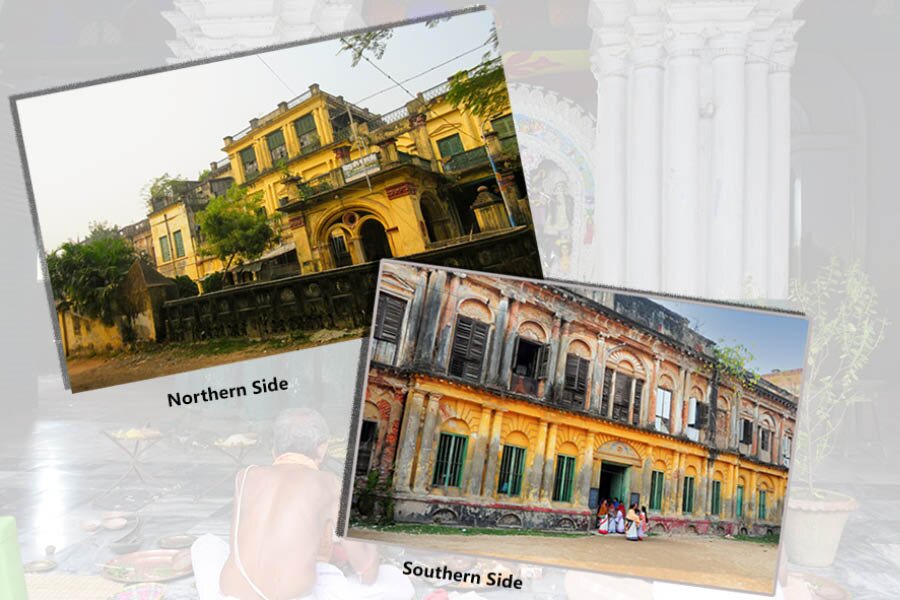
Srirampur Rajbari ( North and South Side) Photo : Surojit Das, Wikimedia Commons
Early family history
The founder of the Srirampur Goswami family, Ramgobinda Goswami, was raised in his maternal home. His maternal grandfather was Achyuta Goswami (born 1506), the son of Advaitacharya Goswami (1434-1559) who was involved in Gaudiya Vaishnava movement. His father, Laxman Chakraborty, married the daughter of Achutya Goswami.
After gaining immense knowledge on the Vaishnava cult and literature, Ramgobinda inherited the properties of his maternal uncle and assumed the title of Gosain or Goswami after converting to the Vaishnava cult from his original Shakta cult.
During a boat journey, Ramgobinda was forced to land at Chatra in Srirampur because his wife went into labour. Hearing the news, the ruler of Sheoraphuli Raj wanted to grant some land to Ramgobinda. Since Ramgobinda could not accept a grant from a non-Brahmin, he accepted the land in exchange of 1 cowrie (an ancient monetary denomination). Later, Ramgobinda built a small aatchala house there to live in. The earliest Durga Puja of the Goswami family was celebrated here in a simple manner. Later, descendants built up a large property.
According to their family tree drafted in 1937 by Banimandir, Ramgobinda had two sons, Ramgopal and Radhakanta. The youngest son of Radhakanta, Harinarayan, functioned as the dewan of customs (collector) under the Danish East India Company. His elder son, Raghuram, had amassed enough wealth through his associations with wealthy and influential British merchant John Palmer (1767-1836).
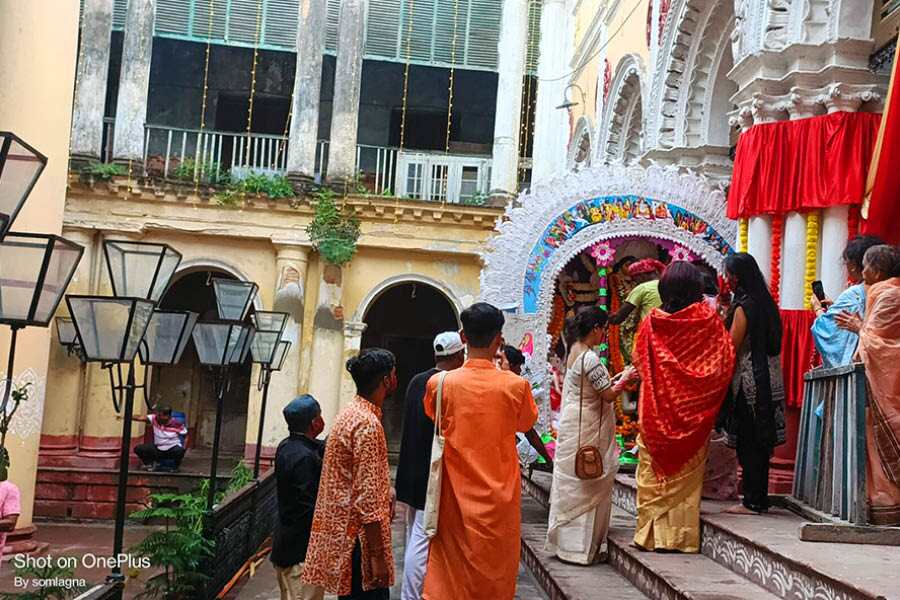
Srirampur Rajbari boasts a five-arched spacious Durga dalan
Raghuram Goswami had shifted to the present location of his descendants, which was initially a small house and known as Puratan Bati. The house attained its present grandeur between the late 18th century and early 19th century. The two-storeyed mansion comprised several structures including a huge natmandir, a five-arched spacious Durga dalan (courtyard) with inner corridors and an array of rooms.
It has been written in many books, including the Hooghly District Gazette by O’Malley, that Harinarayan and Ramnarayan were sons of Ramgobinda and not his grandsons, which does not match with the family narrative.
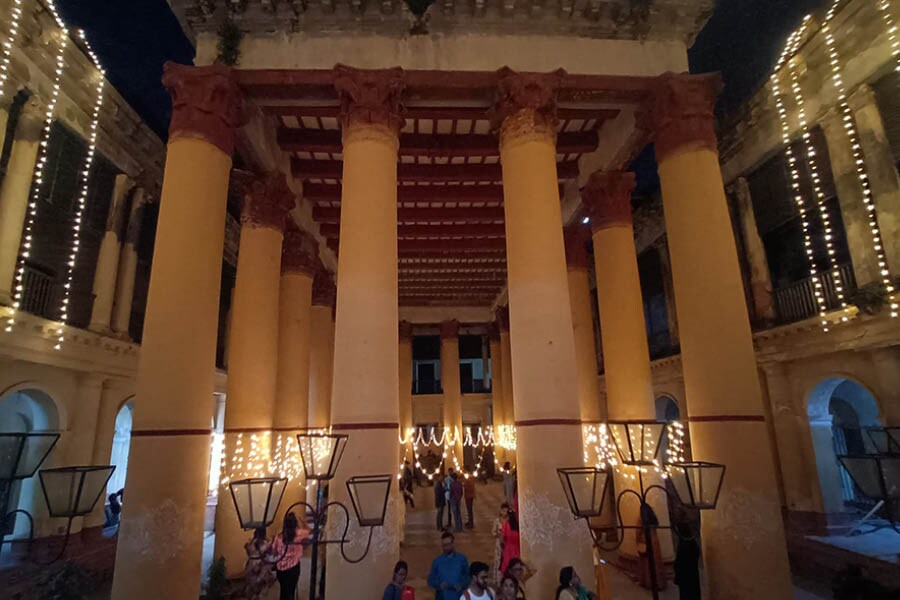
There is a huge Natmandir in front of Durga dalan inside Srirampur Rajbari
Durga Puja of Srirampur Rajbari
The ancestral Durga Puja of the Goswami family takes place in a Durga dalan, which is just about 500 metres from the Rajbari, known as Buri Durga Puja.
Durga Puja in the Srirampur Rajbari was initiated by Raghuram Goswami in the Srirampur Rajbari / Puratan Bati. According to Sibashis Goswami, a senior member of the household (seventh generation from Radhakanta), the puja begun by Raghuram will be celebrating its 341th year this time.
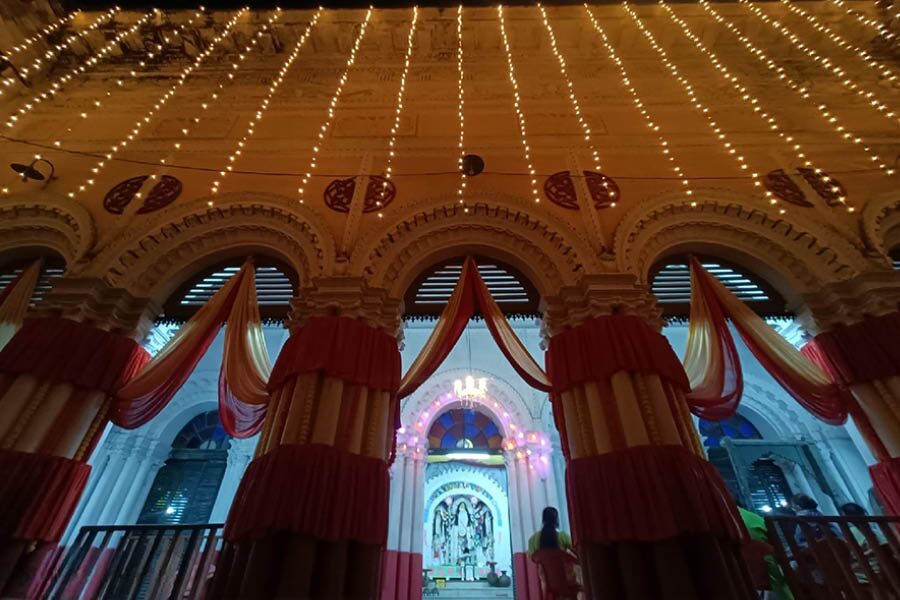
The Durga dalan gets decked with lights during Durga Puja
Kathamo (structure) Puja of the deity takes place on the day of Ratha Yatra. Bodhon takes place on Sashthi. There is a separate room for bodhon adjacent to the thakur dalan, which is treated as the abode of Shiva i.e. Mount Kailash. The seat of the goddess on the thakur dalan is considered to be her home at her paternal place. After bodhon, the ghot on which akal bodhon takes place is brought to the thakur dalan and placed next to the goddess, symbolising her arrival from Kailash.
The deity is dressed in shola (pith) along with silver foil decorations like salma and chumki. The weapons of the goddess are even made of tin with silver foil.
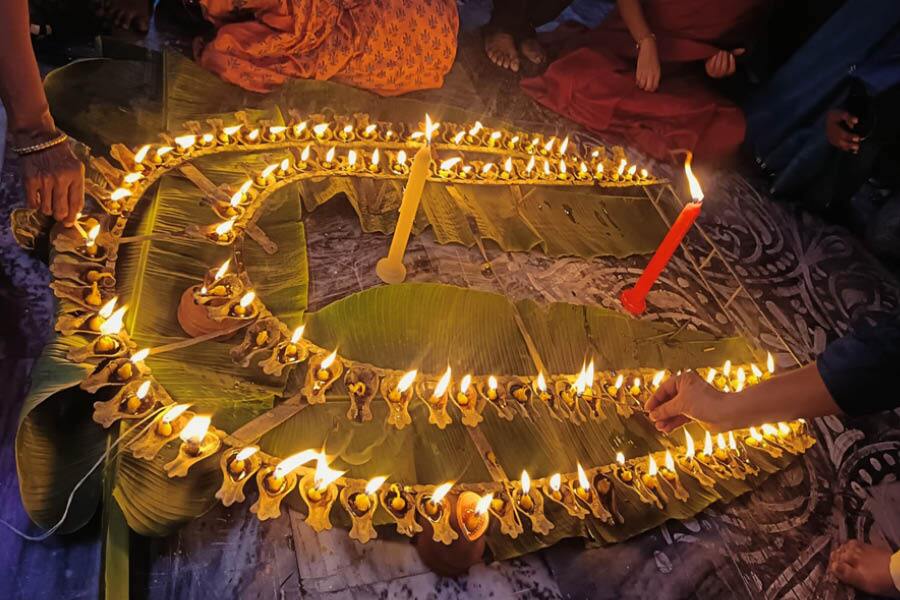
The 'Kulo Pradeep' is lit up during Sandhi Puja. 108 brass lamps have been built together in the shape of a Bamboo Kulo to form a single lamp placed on a banana leaf
The chalchitra is shaped like a bamboo kulo (organising tray for puja). The figures painted on it in a clockwise manner are Jaya, five of the dasavatars (Matsya, Kurma, Varaha, Narasimha, Vaman), killing of asuras (demons) Chanda and Munda by Chamunda, Shiva at Mount, slaying of asura Raktabeej by Durga accompanied by Chamunda, the rest five of the dasavatars (Parashuram, Ram, Krishna, Buddha and Kalki) and finally ending with Vijaya.
Sibashish revealed that the puja is performed at Srirampur Rajbari in adherence to the scriptures written in their own religious book. Here, following the family’s religious texts, the puja is conducted based on a combination of scriptures from Devi Puran, Kalika Puran and Brihat Nadikeshar Puran.
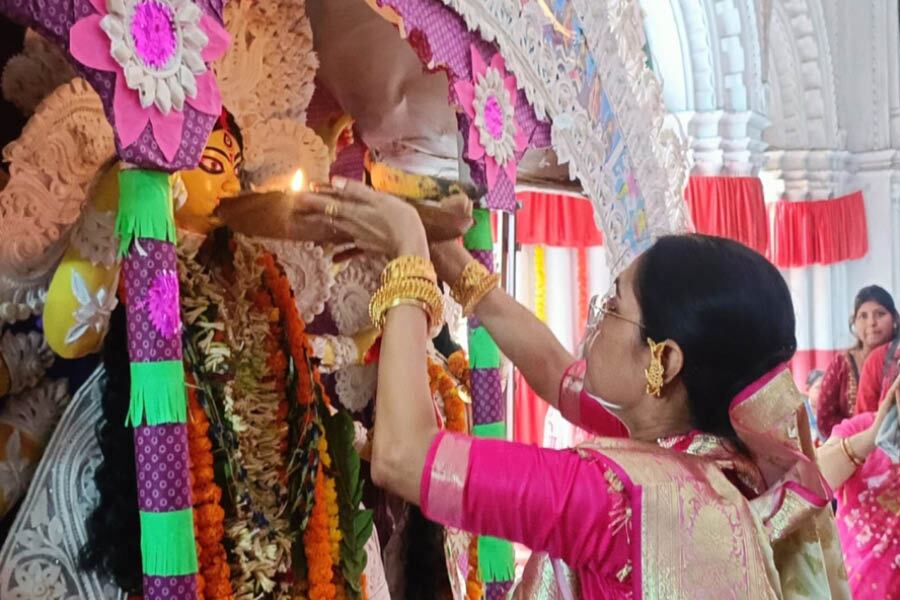
Women members of Srirampur Rajbari performing 'Baran' rituals to the Goddess on Dashami
The puja starts with a ritual known as ghatamalya in the early hours of Saptami. Here, the seniormost women of the house welcome the goddess by putting a garland on the main ghot (tumbler) as if her mother Menoka is welcoming her. Through this ritual, all the activities of Saptami Puja begin. Nabapatrika rituals takes place on the thakur dalan in front the family deity, Radhamadhab. The king of Bishnupur had earlier appointed Ramgobinda as a priest for worshipping three deities Radhamadhab, Radhika and Gopal. Later around 1778, the Raja entrusted their ownership to Gopikrishna, the elder son of Raghuram Goswami. These are worshipped side by side on Durga Puja.
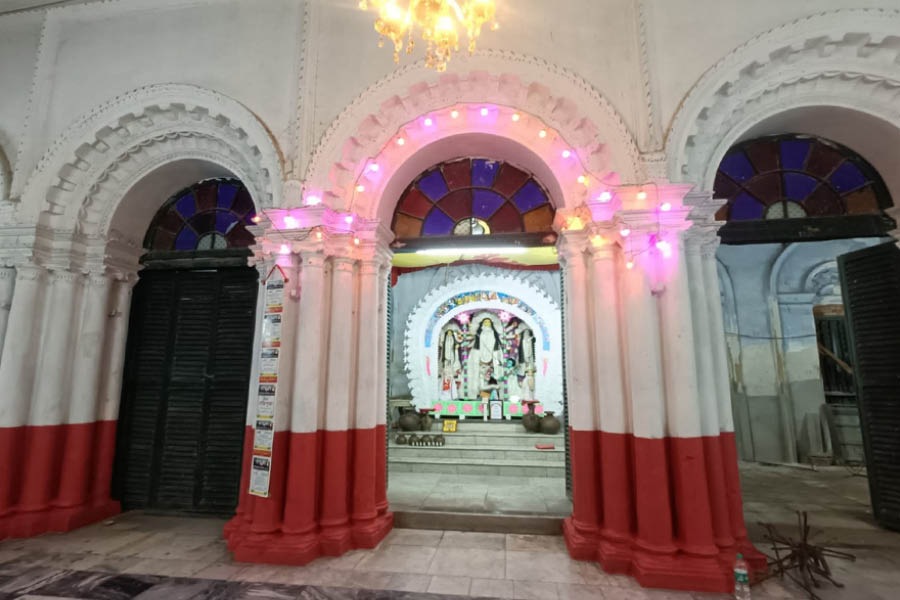
After Ghatamalya ritual is over on Saptami morning, all women and some men of the house are not allowed to access the platform where the deity is residing till the Baran rituals on Dashami afternoon
After instituting nabapatrika besides the goddess, deity of Dhanyalakshmi is placed besides her and worshipped along with the goddess all three days. In this avatar, goddess Lakshmi is responsible for equitable distribution of grains or food and is regarded as the provider of agricultural wealth.
On each day of Saptami, Ashtami and Nabami, along with other gods and goddesses, there is a puja done for all the forms of dasavatar (the 10 avatars of Krishna). On Saptami, Chandi is worshipped, on Ashtami, it’s the turn of Dakhina Kalika and on Nabami, 64 yoginis are worshipped.
Food offering to the deity is known as annabhog (rice offerings), which includes rice, khichudi, dal, five types of fried vegetables, two vegetable curries, chutney, payesh and sweets. Earlier, a special payesh used to be made with fried rice smeared with ghee and without any sugar but with mishri (palm candy) and batasha. A naibedya (offering) of unpeeled fruits is offered to the deity as well as uncooked vegetables.
Not even any vegetable or fruit is sacrificed in this family puja. Instead, a white pumpkin, a sugarcane and a cucumber are presented uncut to the goddess as offering.
During Sandhi Puja, a special brass lamp named kulo pradeep is lit. Here, 108 brass lamps have been built together in the shape of a bamboo kulo to form a single lamp placed on a banana leaf.
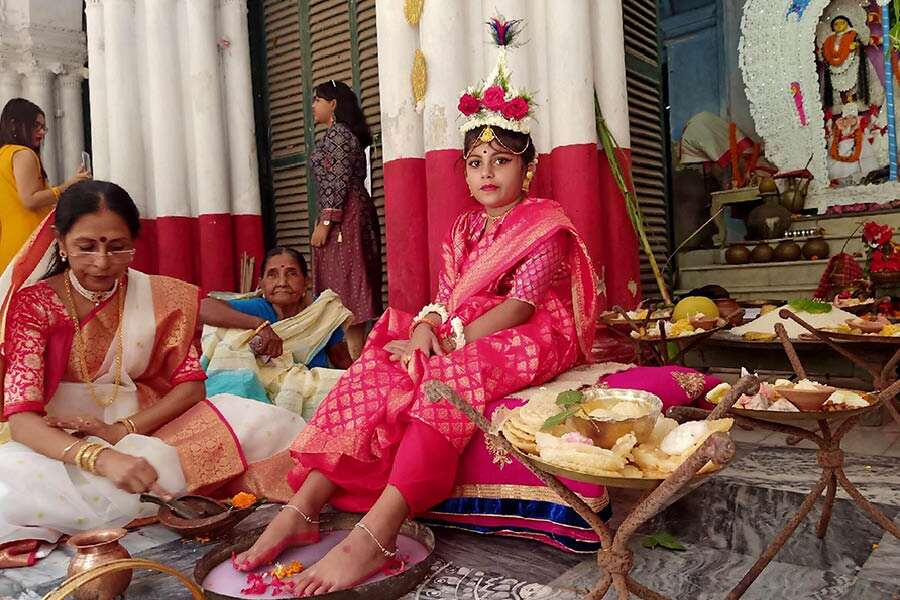
Kumari Puja takes place on Nabami at Srirampur Rajbari
On Nabami, Kumari Puja takes place with a single kumari. Dhuno purano (lac burning) rituals take place with five earthen pots usually involving the seniormost women members of the family.
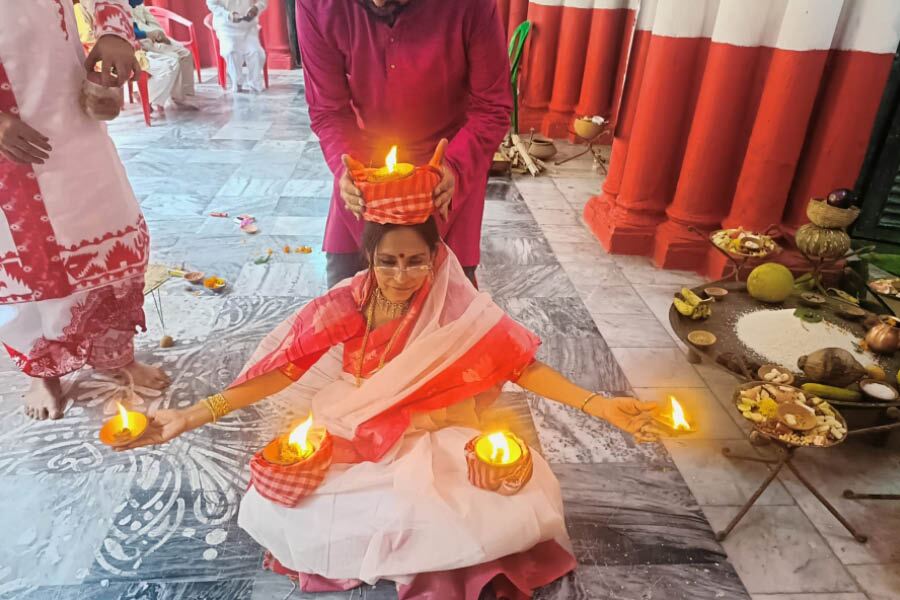
Dhuno Purona ritual takes place with five earthen pot usually involving the senior most female member
On Dashami, it is mandatory for the womenfolk to taste at least one piece of hilsa before performing the boron rituals. The women consume paan without khayer and chuna and the other ingredients are cardamom, aniseed (mouri) and pieces of sweets like sandesh as paan masala were not available in Bengal at that time. The goddess is offered a special type of paan known as Jharkhili paan, whence several small pans are assorted from one single paan leaf. A piece of such paan is affixed to every deity’s palm, including that of the asur. Kanakanjali rituals are observed during Dashami.

Assorted “Jharkhili Paan” where several small ‘paan’ are assorted from one single pan leaf. They are offered to all the deities on Dashami
The goddess is physically carried to the Ganga for immersion. Earlier, the idol used to be immersed midstream using twin boats but the practice was withdrawn after a cyclone on Durga Puja one year.
